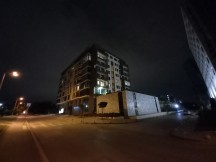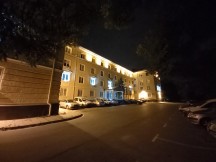Samsung Galaxy A31 review

A familiar camera setup
Samsung's camera choices for the Galaxy A31 are expected and unsurprising in most respects. While devices like the Galaxy A51 and Galaxy M31 put a few twists on a generally familiar mid-ranger setup, the A31 just follows the current convention.

The main 48MP Quad Bayer camera is what you would probably see on most modern midrangers. It is dependable and has proven its salt in numerous occasions.
Accompanying it on the A31 is an 8MP ultrawide snapper. It's a noteworthy downgrade compared to the 12MP unit on the A51.
Complementing these two, we have a duo of 5MP cameras - one is a dedicated depth sensor, with a higher than average megapixel count and an equivalent focal length of around 26mm, allowing you to stand a bit further away from your subject. And finally - a 5MP depth unit to mostly aid in portrait shots. Or "Live focus", as marketed on the A31.
On the front of the phone - there is a 20MP unit. Again, relatively low on the spectrum of current budget Samsungs, which can also be seen featuring 25MP and 32MP units.
Add it all together and also throw in the unfortunate FullHD video capture cap and you get a camera setup that most similar to that on the Galaxy M21, as opposed to most other Galaxy A and Galaxy M alternatives, we have been mentioning throughout the review.

The camera app is the same you'd find on every Samsung with a few minor design tweaks introduced with One UI 2.0 like the larger font for the modes and the outline for the selected mode as opposed to the solid bubble of before.
Functionally, it's mostly identical to any other camera app out there. Swiping left and right will switch between all available modes, and there's also an option to re-arrange or remove some of the modes from the viewfinder. Vertical swipes in either direction will switch between front and rear cameras. The settings icon is located in the upper left corner of the screen and gives you fine control over the cameras. You don't get separate setting screens for photo and video, since the options aren't that many in total. The usual stuff like video resolution, grid lines, location data, etc., can be found there. You can also turn on and off the Scene optimizer. Once on, you still have to toggle it on a second time from the main UI though. Keep that in mind.
Certain options are annoyingly missing, like manual HDR controls. There is an Auto HDR toggle in settings, which leaves the decision to the automatic algorithm. You can't manually force HDR on. Video capture stabilization is also notably missing.
The color Filters and the Beauty mode are somewhat confusingly combined into one interface. The latter includes sliders for skin tone, smoothness, jawline and eye size.
There's a Pro mode too, but as we've come to expect from the company's midrangers, it's not very Pro. You can only choose ISO (in the 100-800 range), exposure compensation (-2/+2EV in 0.1EV steps), and white balance (by light temperature). There's no shutter speed selector or manual focus.
Image quality
Starting with the main camera, the SAMSUNG ISOCELL S5KGM2 sensor, better known by its shorthand GM2 name is a familiar piece of kit. One we know is perfectly capable of capturing great photos. The Quad Bayer module is implemented in a familiar fashion too, sitting behind an f/2.0 lens, with an equivalent of around 26mm width.
Photos captured with it in its default 12MP mode, with Auto HDR and Scene optimizer both enabled, are pleasing and quite satisfactory, even if not amazing. There is a lot of detail, noise is kept at bay well, and dynamic range is surprisingly wide.






Main 12MP camera samples: Auto HDR and Scene optimizer - ON
Colors come out looking nice too. We were lucky enough to get a bright and sunny day for our shots. Bathing our subjects in light understandably washes the visible colors out a bit. Even so, Samsung's color science on the A31 appears to be airing on the more conservative side. Nothing looks artificially oversaturated even if the sharpening algorithm is a bit heavy-handed in most of these shots. Dare we say, that the A31 is showing signs of more mature processing, which we very much appreciate.



Main 12MP camera samples: Auto HDR and Scene optimizer - ON
The 48MP mode is available if you absolutely insist on getting super large files to little practical benefit. You could potentially extract some more detail going that route, but you'd be sacrificing dynamic range in the process as AutoHDR is disabled. Also, certain fine patterns lead to moiré fringing in this resolution.
Scene optimizer gets automatically disabled in 48MP mode, so you can expect less algorithmic aid as well. For comparison purposes, here are the same three scenes, shot at full Auto in 12MP with Auto HDR and Scene optimizer.
The 8MP, f/2.2 ultrawide camera on the Galaxy A31 is serviceable, but not much beyond that. The level of detail is OK, considering its resolution. Though, we would have very much preferred having the 12MP module from the Galaxy A51. Dynamic range is narrow, noise is an issue throughout the frame, and sharpening is heavy-handed. On a positive note, we do like how the colors came out.
It is worth noting that all of the above photos were taken with both Auto HDR and Scene optimizer on. Just like the main camera, there is no point in turning any one of these systems off.
Low light photos out of the Galaxy A31 aren't great. The main camera's output is soft and noisy, while the colors are relatively desaturated. At least dynamic range is decent.
As expected, the ultrawide camera fairs even worse in these conditions.






Ultrawide 8MP low-light samples
The Galaxy A31 notably lacks a dedicated Night mode. That's an unfortunate reality. The best you can do for your night shots is no leave the scene optimizer on.
Portraits
The Galaxy A31 has a pair of supplementary 5MP snappers in its main camera array, which are both put to surprisingly good use. Starting with the depth sensor, it does a splendid job of gathering information for portrait shots. Or as Samsung calls these - Live focus.
Subject detection and separation in these shots is exemplary. The algorithm only misses its mark very rarely, typically with fine detailed patterns. The applied blur looks great at its default 5/7 setting. You can adjust its intensity both before and after taking a photo, which is great versatility.
Live focus works on non-human subjects as well. Though, the algorithm prefers seeing a face, and capturing objects is a lot fiddlier. Even so, the mode is nice enough to constantly give you directions on distance in the viewfinder, as well as a reassuring "OK" label, once it thinks it's got the scene figured out. Results can be surprisingly usable.




Live focus samples with non-human subjects
Close-ups
The dedicated 5MP, fixed-focus, f/2.4 snapper on the Galaxy A31 can produce surprisingly good shots too. It does require some patience and practice to get the distance from the subject just right, though. The focus plane is fairly narrow.
We appreciate Samsung's decision of not upscaling these shots and leaving them in their native 5MP resolution.
We also shot our usual posters with the Galaxy A31. Here's how it stack-up against the competition. Feel free to browse around and pit it against other phones from our extensive database.



Samsung Galaxy A31 against the Samsung Galaxy A51 and the Xiaomi Redmi Note 9 in our Photo compare tool
Selfie camera
The Galaxy A31 has a 20MP, f/2.2 selfie shooter. Yet, it produces shots with a resolution of around 8MP. The sensor used here is the SK Hynix Hi-2021 - part of their Black Pearl CIS lineup, specifically optimized for ultrawide and selfie use and rocking a 1.0μm sensor, down from the 1.12μm in its predecessor. It uses a Bayer algorithm. More specifically - "Quad Pixel function to resize the pixel areas, as well as the Quad to Bayer (Q2B) Re-mosaic algorithm that is more efficient compared to the one adopted in competing products". Circling back to the 8MP figure, there seems to be some constant upscaling at play here.
Regardless if the specific pixel math going on behind the scenes, results look very impressive. Selfies have plenty of detail and look really sharp. Colors are pleasing. The dynamic range is impressive for a selfie camera. We particularly like how the Galaxy A31 handles bright light and heavy shadows in the same frame.
Like many other Samsung phones, the selfie on the A31 has a toggle to determine how wide the frame will be. This setting annoyingly defaults to the narrower option, which is unfortunately also the norm with Samsung devices. When shooting in the wider aspect, selfies come out in 12MP, adding yet another interesting spin on the inner-working of the Bayer algorithm.
The absence of Scene optimizer for the A31 selfie camera is also noteworthy. You do still get Auto HDR, though. There is a filters menu, which also houses the Beauty sliders. Four of them, to be exact. Here are some sample Beauty mode shots. The effects are rather subtle, compared to other implementations we have seen.



Beauty mode selfie samples: Off • Medium • Max
Selfie portraits are a thing on the A31 and surprisingly impressive, at that. Subject separation with a single camera is hard to pull off, and Samsung has done a great job of it.
SK Hynix specifically boasts about improved low-light performance on the Hi-2021 and we're inclined to agree. After all, it is a fairly big sensor that also gets to benefit from Quad Bayer tech. The Galaxy A31 is relatively well-behaved when it comes to preserving detail, sharpness and keeping noise at bay.
Overall, the selfie snapper on the Galaxy A31 offers a pleasantly-surprising standout experience. The only really unfortunate omission in its feature set is autofocus. That and some soft of stabilization. But, that's just asking way too much out of a budget phone.
Video
The Galaxy A31 is woefully underequipped when it comes to video capture. Even though it theoretically has the resolution to pull-off 4K capture, the DSP inside the Helio P65 can't. The A31 is capped at 1080p and 30fps. You can't even get 60fps at 720p through the default app. The latter is possible via a third-party solution like Open Camera, but the FullHD limitation stands. You can, technically, capture in a 1440 x 1440-pixel square, if that is your thing. These exact limitations apply to video from the main, ultrawide as well as the selfie camera.

By default, videos get encoded with an AVC video stream at 17 Mb/s and two-channel, 48 kHz AAC audio, inside an mp4 container. The Galaxy A31 does allow you to use HEVC (h.265) instead, if you are after some space-saving, at the potential expense of a bit of quality.
Videos from the main camera come out looking a bit washed and desaturated in terms of colors. Dynamic range is sub-par and sharpening is heavy-handed.
The ultrawide surprisingly fairs a bit better with color reproduction. Also, thanks to its wider aspect, it seems naturally less susceptible to camera shake.
The lack of any kind of stabilization, OIS or EIS, is another unfortunate reality on the Galaxy A31.
We captured a quick clip in low light, so you can check out how the Galaxy A31 fairs in these conditions as well.
The selfie camera on the A31 continues to impress in the video department, as well. Aside from the obvious omission of autofocus and stabilization, the 20MP SK Hynix Hi-2021 module really comes through with impressive detail and dynamic range. We would even go as far as saying that it's a good enough experience for casual vlogging. If that is your thing.
Finally, closing the camera section off, here is the Galaxy A31 in our video comparison database.



Samsung Galaxy A31 against the Realme 6i and the Xiaomi Redmi Note 9 in our Video compare tool
Reader comments
- Sami
- 16 Jul 2024
- CcC
I am from Ethiopia my phone is Samsung galaxy A 31 call recorder is not available
- Yih
- 15 Jun 2024
- NgW
I have been using A31 6gb for the past 4 yrs. No issues until now except for android 12 only. The camera is very good in daytime. Battery is excellent. Only occasionally lags
- Sajayan
- 28 Feb 2024
- rAT
You should go to some service point bro. Am using the same from past 5 years and never ever faced bettery issues Single charge, it works whole day without having any issues so far till now




































































